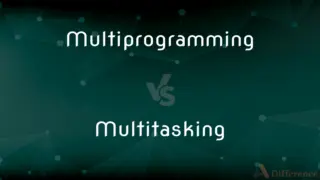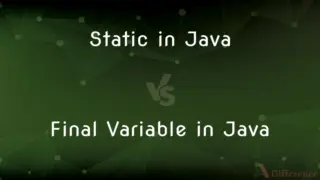FPGA vs. CPLD — What's the Difference?
By Tayyaba Rehman — Published on January 3, 2024
FPGA (Field-Programmable Gate Array) is flexible with complex tasks but higher power usage, while CPLD (Complex Programmable Logic Device) suits simpler tasks with lower flexibility and power consumption.

Difference Between FPGA and CPLD
Table of Contents
ADVERTISEMENT
Key Differences
FPGAs are reprogrammable integrated circuits, offering high flexibility for complex designs. They use a grid of logic blocks connected through programmable interconnects.
CPLDs are fixed architecture devices, suitable for less complex tasks. They use macrocells with fixed interconnections, enabling faster operations with lower power consumption.
FPGAs excel in handling complex tasks due to their extensive logic blocks and flexible interconnects, ideal for varied applications like AI, networking, and image processing.
CPLDs focus on simpler tasks, leveraging fewer logic blocks but faster operational times. They suit tasks requiring predictable, fast, and low-power logic implementations.
FPGAs support complex designs due to their large-scale integration and reprogrammable nature, allowing designers to implement diverse functionalities.
ADVERTISEMENT
CPLDs provide deterministic behavior for straightforward tasks, ensuring predictable responses and swift execution with lower power consumption.
Comparison Chart
Flexibility
Highly flexible with extensive logic blocks and interconnects
Less flexible with fixed architecture and macrocells
Complexity Handling
Suitable for complex and varied designs
Best for simpler, predictable tasks with fixed architectures
Power Consumption
Tends to consume more power due to its flexibility
Lower power consumption due to fixed architecture
Applications
Widely used in complex applications like AI and networking
Applied in simpler tasks needing predictable operations
Logic Blocks
Has numerous logic blocks connected through programmable interconnects
Uses fewer logic blocks with fixed interconnections
Compare with Definitions
FPGA
Versatile reprogrammable circuits.
FPGAs accommodate different functionalities via reprogramming.
CPLD
Simple, predictable tasks.
CPLDs excel in straightforward logic implementations.
FPGA
Extensive logic blocks and interconnects.
FPGAs boast vast logic blocks for diverse functionalities.
CPLD
Swift, deterministic logic.
CPLDs provide rapid and predictable logic execution.
FPGA
High flexibility with programming.
Programmable interconnects make FPGAs adaptable.
CPLD
Lower power consumption.
CPLDs consume less power due to their fixed nature.
FPGA
Flexible for varied applications.
FPGAs are used in AI, networking, and diverse computing.
CPLD
Limited, fixed interconnections.
CPLDs use fixed connections for faster operations.
FPGA
Reconfigurable integrated circuit.
FPGAs allow dynamic reprogramming for various functionalities.
CPLD
Fixed architecture logic device.
CPLDs offer fixed logic for predictable operations.
Common Curiosities
Are FPGAs only used in complex computing tasks?
No, while they excel in complex applications, FPGAs are adaptable and find usage in varied fields.
Can CPLDs be reconfigured after manufacturing?
No, CPLDs have fixed architecture and cannot be reprogrammed after manufacturing.
Are FPGAs more power-efficient compared to CPLDs?
Generally, CPLDs consume less power due to their fixed architecture compared to FPGAs.
How are FPGAs reprogrammed for different functionalities?
FPGAs are reprogrammed through hardware description languages or specialized tools.
Are FPGAs more expensive compared to CPLDs?
Yes, FPGAs tend to be more expensive due to their higher complexity and versatility.
Can CPLDs handle complex designs like FPGAs?
Not typically. CPLDs are more suited to simpler and predictable tasks compared to the flexibility of FPGAs.
Can FPGAs be used in real-time applications?
Yes, FPGAs are used in real-time applications like signal processing and data streaming due to their flexibility.
Can CPLDs handle diverse functionalities?
While they're not as versatile as FPGAs, CPLDs can manage various straightforward tasks.
What are the advantages of using CPLDs over FPGAs?
CPLDs offer faster operations and lower power consumption, ideal for specific predictable tasks.
Can CPLDs support parallel processing?
Yes, CPLDs can manage parallel processes, but they are generally used for simpler tasks compared to FPGAs.
Share Your Discovery

Previous Comparison
Multiprogramming vs. Multitasking
Next Comparison
Static in Java vs. Final Variable in JavaAuthor Spotlight
Written by
Tayyaba RehmanTayyaba Rehman is a distinguished writer, currently serving as a primary contributor to askdifference.com. As a researcher in semantics and etymology, Tayyaba's passion for the complexity of languages and their distinctions has found a perfect home on the platform. Tayyaba delves into the intricacies of language, distinguishing between commonly confused words and phrases, thereby providing clarity for readers worldwide.












































